FOPO Committee Report
If you have any questions or comments regarding the accessibility of this publication, please contact us at accessible@parl.gc.ca.
There is anecdotal evidence that basic aquaculture was first practised in Canada by aboriginal peoples who transferred fish between streams and rivers. The earliest detailed records of planned aquaculture activity, however, date from 1857. They indicate that the first Superintendent of Fisheries in Lower Canada studied the incubation and hatching of Atlantic salmon and brook trout eggs. Shortly thereafter, in 1865, oyster production began in Prince Edward Island. The island government passed a statute providing for the leasing of specific areas for such an activity. By 1950, federal and provincial hatcheries were producing approximately 750 million freshwater fish and freshwater spawning fish annually for wild stock enhancement and non-commercial stock expansion.
Commercial aquaculture in Canada began in the 1970s, and has since expanded.1 Aquaculture production takes place in all ten provinces and all three territories. Production varies widely across provinces; for instance, Manitoba has the lowest level of production (7 tonnes in 2000), while B.C. has the highest (56,440 tonnes in 2000). The predominant species raised in Canada are Atlantic salmon, rainbow trout, mussels, oyster, scallops, and clams. Other species such as Arctic char, tilapia, Atlantic cod, sea urchins, halibut, haddock, and sea cucumbers are in the developmental stages, or are raised in small quantities.
Several factors have contributed to the growth of the Canadian industry, namely: (1) an increase in the overall demand for seafood, both domestically and in export markets; (2) declining populations of some wild stocks; (3) improvements in production and transportation techniques; and (4) proximity to the U.S. market.2
Aquaculture development varies across the country as a result of such factors as policy changes in different jurisdictions. For instance, in 1962, changes to the Ontario Fish and Game Act allowed the private sector to raise and sell rainbow and brook trout for human consumption, and to commence stocking of smallmouth and largemouth bass. This set the stage for the beginning of commercial trout aquaculture in Ontario.3
Mussel culture became established in the 1970s in Atlantic Canada. Prince Edward Island (P.E.I.) is now the province with the greatest mussel production; in 2000, it produced about 17,895 tonnes, or 84% of Canadian farmed mussels.4
Salmon aquaculture started in the late 1970s on the East Coast in the Bay of Fundy, between New Brunswick and Nova Scotia, and on the West Coast in B.C.’s Sechelt Inlet and Alberni Inlet. British Columbia has become the largest grower of commercial finfish, producing 49,500 tonnes in 2000 — 54% of total Canadian finfish production.
The growth of the Canadian aquaculture industry over the 15 years from 1986 to 2000 is illustrated in figures 1 and 2. As shown in Figure 1, production increased substantially during this period. Although shellfish production increased by 352%, finfish production, which grew by 2,700%, was the driving force behind overall aquaculture growth.
Figure 2 illustrates how the value of finfish and shellfish changed over the same period. Finfish sales were the main factor in the dramatic growth in total sales (1,642%). The value of shellfish rose 466%, while finfish value increased 2,060%.
Figure 1: Canadian Aquaculture Production, 1986-2000
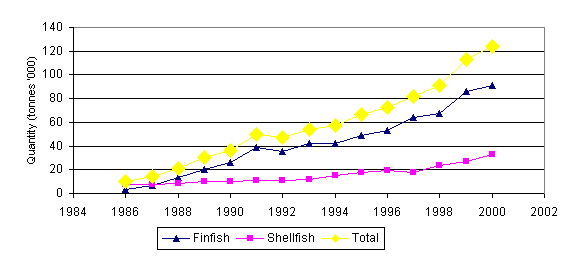
Figure 2: Value of Canadian Aquaculture, 1986-2000
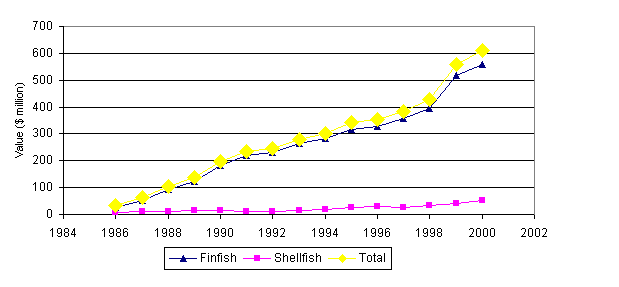
Through the 1980s and early 1990s, as fish feed-manufacturing, applied scientific research, and industry infrastructure evolved, the industry expanded into every province.5 In 2000, the Canadian aquaculture industry produced 91,195 tonnes of finfish and 32,729 tonnes of shellfish, for an aggregate total of 123,924 tonnes of seafood (Table 1). Finfish production accounts for about 74% of all aquaculture production in Canada, with salmon accounting for most of finfish production (86%). The bulk of all production takes place in British Columbia, which produces mostly salmon, followed by New Brunswick. Prince Edward Island is the third largest producer in terms of weight, though it primarily produces mussels.
Table 1: Canadian Aquaculture Production, 2000 (tonnes)
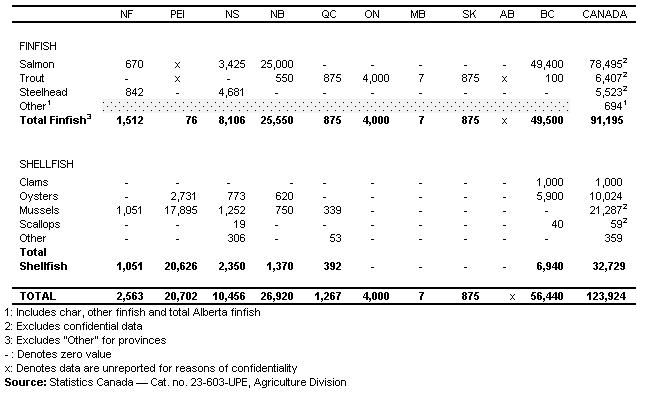
The value of aquaculture production is given in Table 2. Overall, the value of all Canadian aquaculture production in 2000 was $611,572,000, up 9.6% from 1999; this was the slowest growth rate in the last three years. Statistics Canada speculates that one factor behind this slower growth could have been an increase in imports of farmed salmon into both Canada and the United States, combined with declining prices.
Largely based on its salmon production, British Columbia garnered the greatest proportion of this value ($281.7 million — 46%), with New Brunswick second ($190 million — 31%). Combined, these two provinces accounted for about 77% of total national sales in 2000. Sales in New Brunswick rose about 26% between 1999 and 2000 and are catching up to levels in British Columbia. Farmers in British Columbia recorded sales of $295.1 million, down about 2% during this period.
Table 2: Value of Canadian Aquaculture Production, 2000
($ 000)
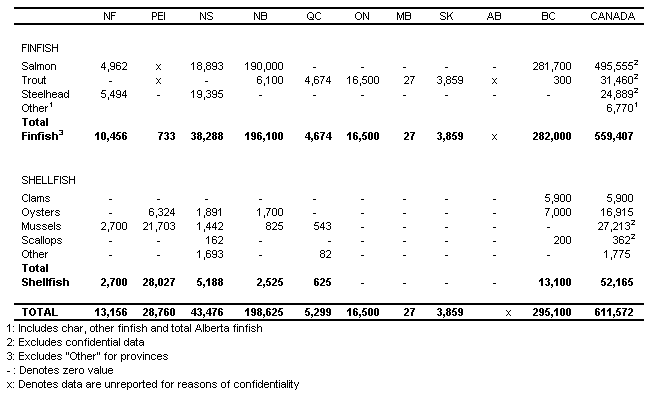
Exports expanded substantially during the 1990s, as shown in Figure 3 and Figure 4. By 2000, the quantity of finfish exported was 144% higher than in 1992, while the quantity of shellfish exported was more than 700% higher than in 1992.
Figure 3: Canadian Aquaculture Exports — Finfish, 1992-2000
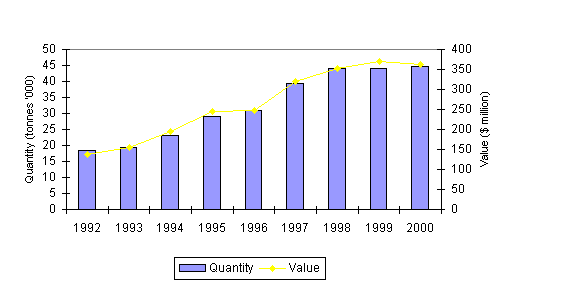
Figure 4: Canadian Aquaculture Exports — Shellfish, 1992-2000
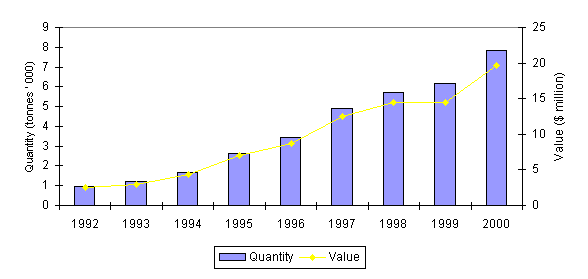
In 2000, about 42% of aquaculture products were exported. According to Statistics Canada, the United States is Canada’s top market for exports. Almost all Canadian finfish and shellfish exports are sold to states along the eastern and western coasts of the U.S., with France, Japan, and Taiwan taking the remainder. Table 3 gives the export data for 2000. The exported items are mussels, coho and chinook salmon, and Atlantic salmon; Atlantic salmon accounts for about 79% of the quantity exported.
Table 3: Exports of Selected Canadian Aquaculture Products, by Country, 2000
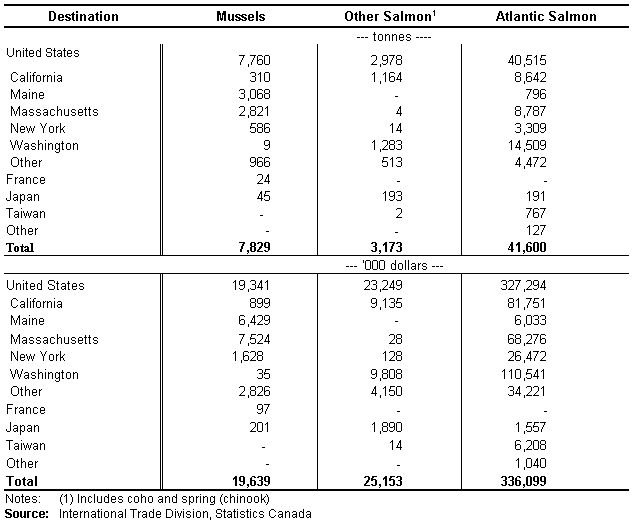
It is difficult to determine the number of full-time equivalent (FTE) jobs that are created by the aquaculture industry in Canada. According to the Canadian Aquaculture Industry Alliance, the production and supply and service sectors account for 7,000-8,000 direct and indirect jobs. Rough estimates by Statistics Canada, however, indicate that the number of full-time equivalent jobs in medium and large aquaculture operations was 3,850 in 2000. Comparable information for small operators is not recorded, and hence is unavailable. Estimates of indirect jobs are difficult to ascertain, and are unverified.
In 1995, the Federal Aquaculture Development Strategy projected, given certain critical success factors, that the total farm-gate value of Canadian aquaculture could reach $680 million by the year 2000 and employ in excess of 8,000 people directly in production and a further 4,000 in services to the industry. In total, the aquaculture sector could generate more than $1.2 billion annually, half of which would come from export sales.6 Those expectations have been essentially fulfilled. Sales of products and services in 2000 amounted to $674 million. DFO’s Aquaculture Policy Framework reports that the sector currently employs in excess of 14,000 people and approaches $1 billion in direct and indirect economic activity.7
What is the potential for growth of Canada’s aquaculture industry? The Framework observes that, “despite its numerous positive attributes, Canada’s contribution to global aquaculture remains small and static at 0.2%.” Most major traditional capture fisheries around the world have already reached or exceeded maximum sustainable harvest rates. If per capita consumption of fish is to keep pace with population growth, aquaculture production will have to meet the growing gap between traditional fisheries production and demand. The FAO predicts that by the year 2030, aquaculture will dominate fish supplies and less than half the fish consumed will originate from traditional fisheries.8 Capitalizing on even a small fraction of this demand could mean a significant growth opportunity for the Canadian aquaculture industry.
Both government and industry sources envisage significant growth in the Canadian aquaculture sector. DFO’s Aquaculture Policy Framework projects that, based on current trends and Canada’s significant aquaculture development potential, the aquaculture sector could contribute $3 billion annually to the Canadian economy by 2010. The Canadian Aquaculture Industry Alliance conservatively estimates that the industry could grow to a farm-gate value of $2.5 billion in the same timeframe.9
A study commissioned by Western Economic Diversification Canada concluded that marine finfish farming has the potential to contribute $1 billion annually to the economy of British Columbia alone, resulting in the creation of 20,000 FTE jobs (direct, indirect and induced) by the year 2010.10 Shellfish farming, according to the same study, has the potential to become a $100-million industry and create 1,000 person years of employment.11
When the B.C. government announced on January 31, 2002, that it would lift the moratorium on the expansion of salmon farming in the province, the BC Salmon Farmers Association responded that salmon farmers were prepared to invest $50 to $60 million dollars a year over the next 10 years and that the industry intended to grow at a rate of 10 new farms per year, doubling the number of existing farms in a decade. The goal is to build an industry that will generate $2.4 billion in economic activity every year and create 8,000 new full-time jobs, mostly in coastal areas of the province, within a decade.
Although there are differences between the various projections, taken together they indicate that both government and industry anticipate an expansion of the Canadian aquaculture sector of approximately 100-200% over the next decade. Such growth, if duplicated on both coasts, suggests that either substantially new areas will have to be opened up for aquaculture development, or farm densities will increase markedly in already established areas.
A great deal has transpired since the Committee began its study. A number of the more important initiatives are summarized below.
1999 British Columbia Salmon Farm Siting Policy
In October 1999, the B.C. Provincial Government announced a new Salmon Aquaculture Policy12 in which it made a commitment to implementing the siting criteria recommended in the Salmon Aquaculture Review (SAR). One of the elements of the policy was a two-year action plan to relocate poorly sited operations to new areas where they would meet environmental standards and enjoy community support. At the time, the Policy retained the moratorium on the expansion of stand-alone conventional salmon tenures; the B.C. government announced, however, that it would offer five new freshwater and five new salt water tenures which would pair conventional and closed-containment technologies as an incentive to develop closed-containment systems.
2000 Program for Sustainable Aquaculture in Canada
On August 8, 2000, the Minister of Fisheries and Oceans at that time, Herb Dhaliwal, announced an investment of $75 million in new funding over the following five years to enhance the sustainable development of Canada’s aquaculture industry. This investment was aimed at strengthening the ties among different levels of government, the scientific and academic communities, and the industry to ensure the development of a diverse and competitive industry.
The Program for Sustainable Aquaculture in Canada was designed to provide the industry and government with opportunities to conduct leading-edge research and development, strengthen measures to protect human health through an enhanced shellfish water quality monitoring program, and implement legislative and regulatory reform for the industry.
2000 New Brunswick Bay of Fundy Marine Aquaculture Site Allocation Policy
In October 2000, the Government of New Brunswick released its Bay of Fundy Marine Aquaculture Site Allocation Policy. The Policy, which applies to the Bay of Fundy only, addresses the allocation of sites for Atlantic salmon, alternative finfish, shellfish, lobster ponds and other activities, including the culture of echinoderms and marine plants.
2002 British Columbia Salmon Aquaculture Policy
On January 31, 2002, the B.C. government announced that it was ending the moratorium on salmon farming, and that new, comprehensive environmental standards and practices that would allow for the managed expansion of the salmon aquaculture industry in British Columbia, would begin April 30, 2002. The announcement noted that applications for new aquaculture sites would be accepted after April 30, 2002.13 The plan included an aquaculture waste control regulation that entered into force on September 12, 2002. A new aquaculture regulation focused on preventing escapes was approved and ordered on April 19, 2002.
2002 DFO Aquaculture Policy Framework
In May 2002, Fisheries and Oceans Canada released its Aquaculture Policy Framework. The policy is the Department’s response to the 1995 Federal Aquaculture Development Strategy. In the document, DFO states that, as the lead federal agency for aquaculture development, DFO is “committed to creating policy conditions that increase both the public’s confidence that aquaculture is being developed in a sustainable manner and the aquaculture industry’s competitiveness in global markets.”14
2002 Quebec Draft Bill on Aquaculture
In the summer of 2002, the government of Quebec submitted a draft bill respecting commercial aquaculture. The Committee on Agriculture, Fisheries and Food of Quebec’s National Assembly was holding hearings on the matter in the fall of 2002. The object of this draft bill is to provide a framework for aquaculture carried on for commercial purposes, for research or experimentation purposes, and for the operation of fishing ponds. The province wants to ensure the orderly development of the industry in part with a licensing system under which the issuance of licences will be subject to certain authorizations provided for in the provincial Environment Quality Act and the Act Respecting the Conservation and Development of Wildlife.
A great deal has been written about aquaculture in Canada in the recent past, some of it critical, especially where it concerns the farming of Atlantic salmon. The following are some of the major studies.
The 1997 Salmon Aquaculture Review
In 1995, the B.C. Environmental Assessment Office initiated a comprehensive review to determine the environmental risks associated with salmon farming and to recommend methods to mitigate those risks and better manage the fishery. The Salmon Aquaculture Review (SAR) report, 1,800 pages in total, was released in 1997. The SAR found that the industry, as it was then configured, posed a minimal risk to the environment. Nevertheless, the SAR identified concerns related to:
| • | inadequate environmental standards and enforcement mechanisms; |
| • | the lack of a legal framework to set and enforce escape prevention or recapture requirements; |
| • | poor siting of a number of existing operations; and, |
| • | the lack of incentives to develop and adopt new environmental technologies. |
The 49 recommendations of the report were accepted by the B.C. government, which subsequently released a new aquaculture policy in October 1999. According to the B.C. Ministry of Agriculture, Food and Fisheries (MAFF), a majority of the recommendations have been either fully or partially implemented.15 The Salmon Aquaculture Implementation Advisory Committee was established in 1999 to bring together major stakeholder groups to help in the implementation of regulations, policy development and the strategic development of the aquaculture industry in B.C.
The SAR report has since been held up by the salmon farming industry as evidence of the minor environmental effects of salmon farming. Critics have responded, however, that the SAR addressed the industry in its current state, and not the potential effects should it expand. Critics have also observed that the SAR was primarily a “paper study” and that much of the literature reviewed did not apply to the B.C. coast.
December 2000 Report of the Auditor General of Canada
In Chapter 30 of the December 2000 Report to Parliament, The Effects of Salmon Farming in British Columbia on the Management of Wild Salmon, the Auditor General of Canada (AG) found that DFO was not fully meeting its responsibilities to conserve and protect fish under the Fisheries Act. The AG’s report found deficiencies in a number of areas, including:
| • | monitoring of the effects of salmon farms on fish and fish habitat; |
| • | determining how to apply the Fisheries Act to protect fish habitat from the effects of salmon farming; |
| • | planning for risk management in the event of industry expansion; |
| • | scientific information on the risks of disease transfer between wild and farmed salmon; and, |
| • | monitoring of escaped farm salmon. |
2001 Report of the Aquaculture Commissioner
On May 8, 2001, the Aquaculture Commissioner released a report on the first phase of his legislative and regulatory review. The report, entitled Legislative and Regulatory Review of Aquaculture in Canada, contained 36 recommendations on measures that the Commissioner “considered urgent.”
The Commissioner identified four key requirements fundamental to the development of a renewed federal framework for aquaculture:
| • | a clear definition of aquaculture; |
| • | operational stability for aquaculturists; |
| • | the use of risk management approaches; and |
| • | a clear federal development mandate for aquaculture. |
The Commissioner advised that the development and implementation of a renewed legal framework for aquaculture be divided into three components. Two of these components would be undertaken in the short term: (1) a series of “priority initiatives” and (2) a harmonization process in cooperation and agreement with the provinces and territories, (3) substantive legislative changes would be undertaken in the longer term.
2001 Report of the Standing Senate Committee on Fisheries
A June 2001 Report by the Standing Senate Committee on Fisheries, Aquaculture in Canada’s Atlantic and Pacific Regions, also sounded several notes of caution. Among other things, it asked the Auditor General of Canada to conduct a comprehensive audit in the Atlantic region, similar to that conducted the previous year in the Pacific region. It recommended that the Department give due consideration to its legislative mandate for the protection of wild fish and their habitat when responding to recommendations made by the Commissioner for Aquaculture Development. It also asked the federal government to invest more research resources in the area of the environmental, ecological and human health effects of aquaculture.
November 2001 Leggatt Inquiry Into Salmon Farming in British Columbia
The Leggatt Inquiry Into Salmon Farming in British Columbia, sponsored by the David Suzuki Foundation and boycotted by the B.C. government, the federal government and the aquaculture industry, released its report Clear Choices, Clean Waters in November 2001. Among other things, the report recommended: an end to (open) net cage salmon farming by 2005; removing all responsibility for the promotion of salmon farming from Fisheries and Oceans Canada; and maintaining the then current moratorium on the expansion of salmon farming in the province.
November 2002 and January 2003 Pacific Fisheries Resource Conservation Council Advisories
Following a dramatic decrease in the number of pink salmon returning to spawn in the Broughton Archipelago area in the summer of 2002, the Pacific Fisheries Resource Conservation Council (PFRCC) issued an advisory in November 2002, raising concerns over the potential impact of salmon aquaculture and sea lice.16 The PFRCC recommended, in the advisory, that the governments of Canada and British Columbia undertake urgent actions to maximize the safe passage of fish through the Broughton Archipelago during April 2003.
In January 2003, the PFRCC issued another advisory outlining measures the Council believed should be taken to deal with risks to wild salmon stocks, the management of the fisheries and aquaculture industry, and public perceptions of a “confused and contradictory government role in the regulation and encouragement of aquaculture and the protection of wild salmon.”17 The advisory urged a more rigorous application of the precautionary principle; more research into the interaction between wild and farmed salmon; a comprehensive policy giving priority to wild salmon in government decision-making; the integration of government supervision and regulation of wild and farmed salmon into single bay or area management units; and the creation of a Salmon Aquaculture Forum, to build public consensus about the future direction of the industry and to find ways of reducing the risks to wild salmon.
The second advisory was based in part on a report entitled Making Sense of the Salmon Aquaculture Debate: Analysis of issues related to netcage salmon farming and wild salmon in British Columbia, commissioned by the Council in August 2002 and released in January 2003.
| 1 | CyberNatural Software Group, University of Guelph, Canada’s Aquatic Environments: Aquaculture in Canada, Accessed May 17, 2002, www.aquatic.uoguelph.ca/Human/Aquaculture/intro.htm. |
| 2 | The Standing Senate Committee on Fisheries, Aquaculture in Canada’s Atlantic and Pacific Regions, Ottawa, June 2001, p. 5. |
| 3 | Fisheries and Oceans Canada, Office of the Commissioner for Aquaculture Development, Canadian Aquaculture Industry Profile, September 25, 2002, ocad-bcda.gc.ca/eaquaculture.html. |
| 4 | Canadian Aquaculture Industry Alliance, Homepage, Accessed May 17, 2002, www.aquaculture.ca/EnglishWeb.html. |
| 5 | The Standing Senate Committee on Fisheries, Aquaculture in Canada’s Atlantic and Pacific Regions, Ottawa, June 2001, p. 5. |
| 6 | Fisheries and Oceans Canada, Communications Directorate, Federal Aquaculture Development Strategy, Ottawa, 1995, p. 6. |
| 7 | Fisheries and Oceans Canada, Communications Branch, DFO’s Aquaculture Policy Framework, May 2002, p. 12. |
| 8 | UN Food and Agriculture Organization, The State of World Fisheries and Aquaculture 2000, Part 4, Outlook, www.fao.org/DOCREP/003/X8002E/x8002e07.htm#P1. |
| 9 | Canadian Aquaculture Industry Alliance, Brief to the Committee, October 30, 2001. |
| 10 | Western Economic Diversification Canada, Economic Potential of the British Columbia Aquaculture Industry, Phase II — Fin Fish, undated, p. i. |
| 11 | Western Economic Diversification Canada, Economic Potential of the British Columbia Aquaculture Industry, Phase I — Shellfish, undated, p. i. |
| 12 | B.C. Ministry of Fisheries, News Release, “Streifel, Sawicki Announce Salmon Aquaculture Policy,” October 18, 1999. |
| 13 | B.C. Ministry of Agriculture, Food and Fisheries, Press Release, “New standards to be set for sustainable aquaculture,” NR 02-01, January 31, 2002. |
| 14 | Fisheries and Oceans Canada (2002), DFO’s Aquaculture Policy Framework, p. 3. |
| 15 | B.C. Ministry of Agriculture, Food and Fisheries, Backgrounder, "B.C. Salmon Aquaculture Policy," MAFF #02-01, January 31, 2002, p. 6. According to the backgrounder, 23 recommendations have been fully implemented while 16 have been partially implemented. |
| 16 | Pacific Fisheries Resource Conservation Council, 2002 Advisory: the Protection of Broughton Archipelago Pink Salmon Stocks, Report to the Minister of Fisheries and Oceans Canada and the Minister of Agriculture, Food and Fisheries of British Columbia, November 2002. |
| 17 | Pacific Fisheries Resource Conservation Council, Advisory: Wild Salmon and Aquaculture in British Columbia, Report to the Minister of Fisheries and Oceans Canada, to the Minister of Agriculture, Food and Fisheries of British Columbia, and to the Canadian public, January 2003. |